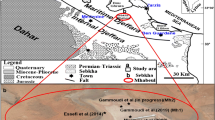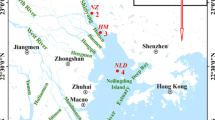Abstract
This paper analyzes the mass fractions of Ce, Co, Cr, Cs, Eu, Fe, Hf, K, La, Lu, Nd, Rb, Sc, Sm, Ta, Tb, Th, U, Yb and Zn determined from sixty sediment samples obtained from the Lapa Grande de Taquaraçu archaeological site using instrumental neutron activation analysis, INAA. The archaeological site is located in the municipality of Jaboticatubas, about 60 km from Belo Horizonte, Minas Gerais State, Brazil. The dataset was explored by means of cluster analysis, principal component analysis and discriminant analysis. The study showed three different compositional groups related to anthropogenic sediment, fluvial system and oxisols, respectively. The crystalline structure of each group were studied using X-ray diffraction, XRD.










Similar content being viewed by others
References
Konrad VA, Bonnichsen R, Clay V (1983) Soil chemical identification of ten thousand years of prehistoric human activity areas at the Munsungun Lake Throroughfare, Maine. J Archaeol Sci 10:13–28
Cavanagh WG, Hirst S, Litton CD (1988) Soil phosphate, site boundaries, and change point analysis. J Field Archaeol 15:67–83
Arrhenius O (1929) Die phosphoatfrage. Z Pflanzenenernahrung Dungung Bodenkunde 10:185–194
Craddock PT, Gurney D, Pryor F, Hughs M (1986) The application of phosphate analysis to the location and interpretation of archaeological sites. Archaeol J 142:361–376
Holliday VT, Gartner WG (2007) Methods of soil P analysis in archaeology. J Archaeol Sci 34(2):301–333
Wells EC, Terry RF, Parnell JJ, Hardin PJ, Jackson MW, Houston SD (2000) Chemical analyses of ancient anthrosols in residential areas at Piedras Negras, Guatemala. J Archaeol Sci 27:449–462
Kämpf N, Woods WI, Sombroek W, Kern DC, Cunha TJ (2003) Classification of amazonian dark earth sand other ancient anthropic soils. In: Lehmann J et al (eds) Amazonian dark earths: origin, properties, management. Springer, Dordrecht, pp 77–102
Costa ADR, Silva Junior ML, Kern DC, Ruivo MDLP, Marichal R (2017) Forms of soil organic phosphorus at black earth sites in the Eastern Amazon. Rev Ciênc Agron 48(1):1–12
Middleton WD (2004) Identifying chemical activity residues on prehistoric house floors: a methodology and rationale for multi-elemental characterization of a mild acid extract of anthropogenic sediments. Archaeometry 46(1):47–65
Dardenne MA (1981). Os grupos Paranoá e Bambuí na faixa dobrada Brasiliana. Anais do Simpósio sobre o Cráton de São Francisco e suas Faixas Marginais, novembro 2–7, Salvador, Bahia, pp 140–157
Alkmin FF, Martins AMN (2001) A bacia intracratônica do São Francisco. Arcabouço estrutural e cenários evolutivos. In Sociedade Brasileira de Geologia, Núcleo de Minas Gerais (Ed.), Bacia do São Francisco: Geologia e Recursos Naturais. Belo Horizonte, Minas Gerais, pp 9–30
Flores RA, Sousa JCM, Araujo AGM, Ceccantini G (2016) Before Lagoa Santa: micro-remain and technological analysis in a lithic artifact from the Itaperica industry. J Lithic Stud 3(1):6–29
Piló LB (1998) Morfologia cárstica e materiais constituintes: dinâmica e evolução da depressão poligonal macacos-baú-carste de Lagoa Santa, MG. Doctoral dissertation, FFLCH—University of São Paulo
Danzeglocke U, Jöris O, Weninger B (2007) CalPal online (Version 1.5). University of Cologne, Germany. http://www.calpal-online.de. Accessed date August 2015
Teixeira W, Toledo MC, Fairchild TR, Taioli F (2008) Decifrando a Terra. Companhia Nacional (Ed.), 2nd ed. São Paulo
Araujo AG, Feathers JK, Arroyo-Kalin M, Tizuka MM (2008) Lapa das boleiras rock shelter: stratigraphy and formation processes at a paleoamerican site in Central Brazil. J Archaeol Sci 35(12):3186–3202
Araujo GM, Neves WA, Kipnis R (2012) Lagoa Santa Revisited: an overview of the chronology, subsistence, and material culture of paleoindian sites in eastern central Brazil. Lat Am Antiq 23:533–550
Araujo AGM, Piló LB (2017) Towards the development of a tropical geoarchaeology: Lagoa Santa as an emblematic case study. In: Da-Gloria P et al (eds) Archaeological and paleontological research in Lagoa Santa. Springer, Berlin, pp 373–391
Silva LV, Prous AP (2014) O papel dos resíduos de combustão na formação dos estratos sedimentares na Lapa do Niactor: o elemento antrópico como agente dominante na sedimentação em abrigos. Arq Museu Hist Nat UFMG Belo Horiz 23(2):105–139
Stein JK, Kornbacher KD, Tyler JL (1992) British camp shell midden stratigraphy. In: Stein JK (ed) Deciphering a shell midden. Academic Press, Cambridge, pp 95–134
Hazenfratz R, Munita CS, Neves EG (2018) Neural networks (SOM) applied to INAA data of chemical elements in archaeological ceramics from central Amazon. Sci Technol Archaeol Res 3(2):334–340
Rorabacher DB (1991) Statistical treatment for rejection of deviant values: critical values of Dixon’s “Q” parameter and related subrange ratios at the 95% confidence level. Anal Chem 63:139–146
Kuleff I, Djingova R (1990) Activation analysis in archaeology. In: Alfassi ZB (ed) Activation analysis, vol II. CRC Press, Boca Raton, pp 428–477
Glascock MD (1992) Characterization of ceramics at MURR by NAA and multivariate statistics. In: Neff H (ed) Chemical characterization of ceramics paste in archaeology, monographs in world archaeology. Prehistory Press, New York, pp 11–26
Bishop RL, Canouts V, Crown PL, Atley SP (1990) Sensitivity, precision and accuracy: their roles in ceramic compositional data bases. Am Antiq 55(2):537–546
Arenhs LH (1954) The lognormal distribution of the elements. Geochim Cosmochim Acta 5(2):49–73
Baxter MJ, Freestone IC (2006) Log-ratio compositional data analysis in archaeometry. Archaeometry 48(3):511–531
Grubbs FE (1950) Sample criteria for testing outlying observations. Ann Math Stat 20:27–58
Penny KI (1996) Appropriate critical values when testing for a single multivariate outlier by using the Mahalanobis distance. J R Stat Soc C 45(1):73–81
Oliveira PMS, Munita CS (2003) Influência do valor critico na detecção de valores discrepantes em arqueometria. In Anais da 48° Reunião Anual da Região Brasileira da Sociedade Internacional de Biometria, Lavras, MG, Brasil, 07 a 11 de Julho
Joossens K, Croux C (2004) Empirical comparison of the classification performance of robust linear and quadratic analysis. In: Huber M, Pison G, Struyf A, Van Aelst S (eds) Theory and application of recent robust methods. Verlag Basel, Birkhauser, pp 131–140
Sayre EV, Dodson RW (1975) Brookhaven procedures for statistical analyses of multivariate archaeometric data. Brookhaven National Laboratory Report BNL-23128, New York
Glascock MD, Neff H (2003) Neutron activation analysis and provenance research in archaeology. Meas Sci Technol 14:1516–1526
MacDonald BL, Hancock RGV, Cannon A, Pidruczny A (2011) Geochemical characterization of ochre from central coastal British Columbia, Canada. J Arhcaeol Sci 38:3620–3630
Hair JF Jr, Anderson RE, Tatham RL, Black WC (2005) Análise multivariada de dados, 5a edn. Bookman, Porto Alegre, p 593
Krzanowski WJ (1987) Selection of variables to preserve multivariate data structure, using principal components. Appl Stat 36(1):22–33
Krzanowski WJ (1996) A stopping rule for structure-preserving variable selection. Stat Comput 6:51–56
Munita CS, Barroso P, Oliveira PMS (2013) Variable selection study using procrustes analysis. Open J Archaeom 1:31–35
Canti MG (2003) Aspects of the chemical and microscopic characteristics of plant ashes found in archaeological soils. CATENA 54(3):339–361
Villagran XS, Strauss A, Miller C, Ligouis B, Oliveira R (2017) Buried in ashes: site formation processes at Lapa do Santo rockshelter, east-central Brazil. J Archaeol Sci 77:10–34
Middleton WD, Price TD (1996) Identification of activity areas by multi-element characterization of sediments from modern and archaeological house floors using inductively coupled plasma-atomic emission spectroscopy. J Archaeol Sci 23:673–687
Entwistle JA (2000) The geoarchaeological significance and spatial variability of a range of physical and chemical soil properties from a former habitation site, Isle of Skye. J Archaeol Sci 27:287–303
King SM (2008) The spatial organization of food sharing in early postclassic households: an application of soil chemistry in ancient Oxaca, Mexico. J Archaeol Sci 35:1224–1239
Barba LA (1996) La química en el estudio de áreas de actividad. In: Manzanilla Linda (ed) Análisis de unidades habitacionales mesoamericanas y sus Áreas de actividad. DF, México, pp 21–39
Barba LA (2007) Chemical residues in lime-plastered archaeological floors. Geoarchaeology 22(4):439–452
Barba LA (1990) El análisis químico de pisos de unidades habitacionales para determinar sus áreas de actividad. In: Sigiura Y, Serra MC (eds) Etnoarqueología: coloquio Bosch-Gimpera. México, DF, pp 177–200
Barba LA, Ortiz A, Link KF, López Lujan L, Lazos L (1996) The chemical analysis of residues in floors and the reconstruction of ritual activities at the Templo Mayor, México. In Orna MV (ed.) Archaeological chemistry: organic, inorganic and biochemical analysis. ACS symposium series, vol 625, pp 139–156
Vyncke K, Degryse P, Vassilieva E, Waelkens M (2011) Identifying domestic functional areas. Chemical analysis of floor sediments at the classical-Hellenistic settlement at Düzen Tepe (SW Turkey). J Archaeol Sci 38:2274–2292
Author information
Authors and Affiliations
Corresponding author
Additional information
Publisher's Note
Springer Nature remains neutral with regard to jurisdictional claims in published maps and institutional affiliations.
Rights and permissions
About this article
Cite this article
Tudela, D.R.G., Araujo, A.G.M., Tatumi, S.H. et al. Preliminary evidence of prehistoric human activity by chemical analysis of sediments from Lapa Grande de Taquaraçu archaeological site using INAA. J Radioanal Nucl Chem 325, 725–736 (2020). https://doi.org/10.1007/s10967-020-07217-2
Received:
Published:
Issue Date:
DOI: https://doi.org/10.1007/s10967-020-07217-2




